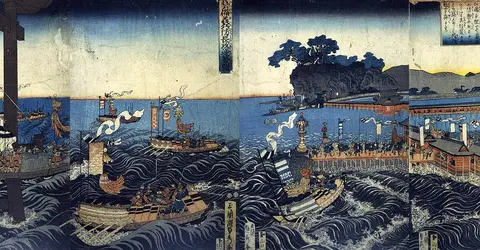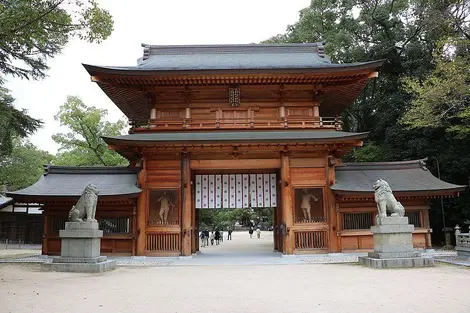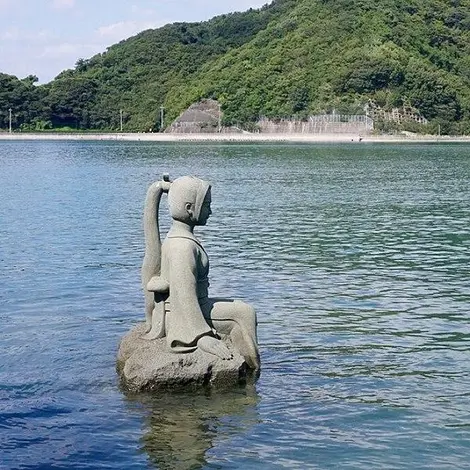Pirates of the Seto Inland Sea 瀬戸内海の海賊と戦闘機
- Published on : 31/05/2019
- by : S.V.
- Youtube
Brave warriors
Demons, Ghosts, and Spirits; Dantesque historical battles; pirates and brave warriors, Japanese myths and folklore... The Seto Inland Sea is at the heart of many legends, famous throughout the land of the rising sun. Let's explore the story of the Murakami and Tsuruhime pirates, the onna-bugeisha who roamed the Seto Inland Sea during the Warring Provinces era (1477-1573).
The Murakami Pirates
From the middle of the 14th century, the archipelago saw a clan, the Murakami, exercise unprecedented domination over the Setouchi area. Called Murakami kaizoku or Murakami pirates, the latter will control the waters of the Seto Inland Sea for two centuries.
At the end of the 16th century, an ordinance promulgated by Hideyoshi Toyotomi prohibiting piracy put an end to their hegemony.
Far from the cliché, inscribed in the collective memory, of the pirate attacking and looting all the ships having the misfortune to cross their path, the Murakami pirates are in reality the combatants of an armed and particularly powerful naval clan. Great navigators, they were among the rare people of the time to be able to face the tumult of the waters of the Seto Sea. This naval competence then ensures their independence; with no one being able to attack them at sea.
The Murakami remains beyond the control of even the highest authorities in the country. But far from sowing chaos in their wake, these pirates maintain order and safety at sea. From their base in the Geiyo Islands, they secure their income through the establishment of a toll system and maritime protection contracts. For a fee, everyone (lord, fisherman, warrior, or craftsman) can obtain the protection of the Murakami in the Seto Sea.
The Battle of Miyajima
In October 1555, the warlord of the Môri clan in conflict with the Ouchi clan offered himself the services of the Murakami kaizoku during the battle of Miyajima. In the only battle, the sacred island has ever known, the Murakami help Mōri Motonari bring his troops to Miyajima. Murakami boats drop anchor near the torii of Itsukushima Shrine during a violent storm.
Taking advantage of the very low visibility, the Mori disembark discreetly on the island and manage to advance masked. This tactic allows the Môri clan to attack two distinct fronts: at sea and on land. More than 4,700 Ouchi warriors perish during the assault on Miyao Castle.
Victorious, Môri Motonari ordered the evacuation of the bodies and the complete washing of the sacred site, going so far as to remove the soil soiled by the blood of his adversaries.

Battle of Miyajima. Print by Utagawa Sadahide
Miyajima Hakubutsukan
Shiratakiyama Temple
Even today, it is possible to see some vestiges left by the Murakami pirates.
Thus on the island of Innoshima , at the top of a hill overlooking the Seto Inland Sea, is the Shiratakiyama temple. This one would have been founded by the head of the kaizoku Murakami, Yoshimitsu Murakami. In this temple, which also served as a lookout post with its breathtaking view of the sea, are enthroned all along the access path the Gohyakurakan or the statues of 500 disciples of Buddha.
The fortress turned museum: Suigun-jo
During the 15th century, the power of the Murakami pirates was such that they were able to build a fortress on the island of Innoshima. Disappeared, the Suigun-jo r will rise from its ashes in 1983 to commemorate the history of the clan .
Built on the site of the old castle, the modern-style building houses a museum displaying the weapons and armor of the Murakami. It is also possible to visit the clan's temple, Koren-ji, located at the foot of Suigun-jo. At the back of the temple, the Murakami tombs recall their past grandeur.
In addition, in Imabari, a museum is entirely dedicated to the history of the Murakami naval force. The collections bring together many artifacts from archaeological excavations carried out in the region as well as remains of pirate ships .
Tsuruhime, the Japanese Joan of Arc
From the conflict between the Ouchi clan and the Kono clan, originally from Iyo province, Japanese history has retained an extraordinary warrior, who has since gone down in history. A fighter to be precise. This is Tsuruhime, an onna bugeisha or samurai woman who is readily assimilated to the Japanese Joan of Arc in the archipelago.
Born in 1526, Tsuruhime is the daughter of the high priest of Oyamazumi jinja , a Shinto shrine founded in 594 on the island of Omishima and dedicated to Ôyamatsumi, god of mountains, oceans and war. In 1541, the young girl saw her destiny changed. In the space of a few months, she loses her two older brothers in the war which has opposed the Ôuchi and the Kônô for several years, then her father who dies of illness. In June of the same year when the Ôuchi clan tried again to invade the island of Omishima, placed under the jurisdiction of the opposing clan, Tsuruhime, then 15 years old, took up arms to try to protect the family shrine .
Trained in martial arts by her father from an early age, the onna bugeisha leads the Kono troops to victory. Tsuruhime no longer presents herself as only the guardian of the Oyamazumi temple but as the incarnation of the god of war, Oyamatsumi.
In October, she repulsed a second Ouchi attack in the waters of the Seto Inland Sea. Dressed in her armor, she leads the Kono fleet and attacks enemy ships without fail. In 1543, the Ouchi clan again sent troops to try to re-establish their supremacy in this area of the Seto Inland Sea. But during this third battle, her fiance Yasunari Ochi dies in battle. Throwing all her strength into battle, the young woman manages to push the Ouchi out of Omishima again.
However, once the battle is over, Tsuruhime unbearable for the loss of her beloved rushes in despair to the depths of the Seto Inland Sea.
The abundant literature retracing the life of the fighter, including the novel A Woman and Her Armor: Joan of Arc of the Seto Inland Sea by Yasukiyo Mishima (1966) lends her last words: "With the Mishima ocean as a witness, my love is engraved in his name".
A place of pilgrimage
The Oyamazumi sanctuary, which since its creation was a place of pilgrimage for all the warriors and samurai of the archipelago who came to pray to Oyamatsumi for victory, preserves a treasure rich in surprises.
In the latter are exposed all the weapons and armor deposited by the fighters as an offering to the local kami. Many of the rooms still bear the scars of past violent confrontations. Among these relics is the armor of Tsuruhime, a smaller and narrower piece than the others whose metal plates are held together by a blue thread.
For further :
- How to get around during the Setouchi Triennale?
- The Shimanami Kaido Cycle Path
- Teshima Island
- Honjima Island
- Ibukijima Island
- Awashima Island
- Shamijima Island
- Takamijima Island
- Ogijima Island
- Megijima Island
- Takamatsu City
- Uno Harbor
- Kosan-ji Temple
- The Myths of the Seto Inland Sea Islands
- Battles and legends in the Seto Inland Sea
- Naoshima's open-air works of art




















